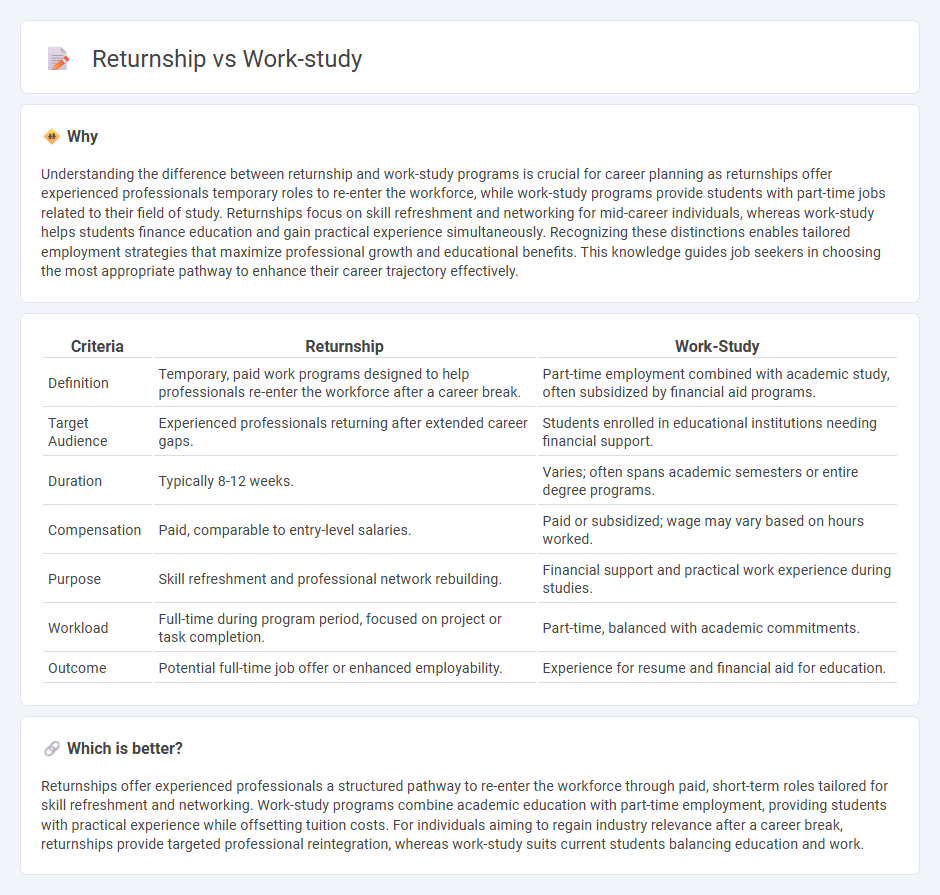
Returnships offer experienced professionals a structured pathway to re-enter the workforce with mentorship and skill refreshment, while work-study programs provide students paid employment opportunities that complement their academic studies. Both options facilitate career advancement and practical experience but cater to distinct demographics--returnships targeting career re-entry and work-study focusing on current students. Discover how each program can uniquely support your employment goals.
Why it is important
Understanding the difference between returnship and work-study programs is crucial for career planning as returnships offer experienced professionals temporary roles to re-enter the workforce, while work-study programs provide students with part-time jobs related to their field of study. Returnships focus on skill refreshment and networking for mid-career individuals, whereas work-study helps students finance education and gain practical experience simultaneously. Recognizing these distinctions enables tailored employment strategies that maximize professional growth and educational benefits. This knowledge guides job seekers in choosing the most appropriate pathway to enhance their career trajectory effectively.
Comparison Table
| Criteria | Returnship | Work-Study |
|---|---|---|
| Definition | Temporary, paid work programs designed to help professionals re-enter the workforce after a career break. | Part-time employment combined with academic study, often subsidized by financial aid programs. |
| Target Audience | Experienced professionals returning after extended career gaps. | Students enrolled in educational institutions needing financial support. |
| Duration | Typically 8-12 weeks. | Varies; often spans academic semesters or entire degree programs. |
| Compensation | Paid, comparable to entry-level salaries. | Paid or subsidized; wage may vary based on hours worked. |
| Purpose | Skill refreshment and professional network rebuilding. | Financial support and practical work experience during studies. |
| Workload | Full-time during program period, focused on project or task completion. | Part-time, balanced with academic commitments. |
| Outcome | Potential full-time job offer or enhanced employability. | Experience for resume and financial aid for education. |
Which is better?
Returnships offer experienced professionals a structured pathway to re-enter the workforce through paid, short-term roles tailored for skill refreshment and networking. Work-study programs combine academic education with part-time employment, providing students with practical experience while offsetting tuition costs. For individuals aiming to regain industry relevance after a career break, returnships provide targeted professional reintegration, whereas work-study suits current students balancing education and work.
Connection
Returnship programs serve as structured opportunities for experienced professionals to re-enter the workforce, often after a career break, while work-study arrangements provide simultaneous employment and educational experience. Both models aim to enhance employability by bridging gaps in skills and work history through practical engagement. Employers benefit from a diverse talent pipeline, and participants gain valuable, on-the-job learning aligned with current industry standards.
Key Terms
Student Employment
Work-study programs provide students with part-time employment opportunities directly related to their academic goals, enabling them to gain practical experience while earning financial aid. Returnships are designed for professionals re-entering the workforce after a career break, offering structured internships to rebuild skills, though less common in student employment. Explore how these pathways can enhance student career readiness and financial stability.
Career Re-entry
Work-study programs offer structured opportunities for students or professionals to gain practical experience while continuing their education, bridging academic knowledge with real-world application. Returnship programs specifically target career re-entry for individuals who have taken extended breaks, providing tailored mentorship and skill refreshment to ease the transition back into the workforce. Explore in-depth insights on how these pathways support career re-entry and which option aligns best with your professional goals.
Skill Development
Work-study programs combine academic learning with on-the-job training, enabling students to gain practical experience while financing their education. Returnships offer career re-entry opportunities for professionals, focusing on upskilling and updating industry-specific skills after a career break. Explore more about how these pathways accelerate skill development and career growth.
Source and External Links
Federal Work-Study Program - The Federal Work-Study Program is a federally funded U.S. program that provides part-time jobs to students with financial need, allowing them to earn money to help pay for postsecondary education expenses while promoting community service and work related to their field of study.
Federal Work-Study - Student Financial Services - Federal Work-Study is a need-based federal grant allowing students to earn money through approved part-time jobs to cover non-billable educational expenses, with eligibility determined by FAFSA and financial need.
8 Things You Should Know About Federal Work-Study - Federal Work-Study jobs are part-time positions that pay at least minimum wage based on skills and job type, with work hours set based on financial need and academic progress to ensure students balance work and study effectively.
 dowidth.com
dowidth.com